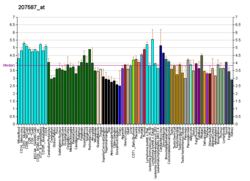Gamma-crystallin A is a protein that in humans is encoded by the CRYGA gene.[5]
{{PBB_Summary
| section_title =
| summary_text = Crystallins are separated into two classes: taxon-specific, or enzyme, and ubiquitous. The latter class constitutes the major proteins of vertebrate eye lens and maintains the transparency and refractive index of the lens. Since lens central fiber cells lose their nuclei during development, these crystallins are made and then retained throughout life, making them extremely stable proteins. Mammalian lens crystallins are divided into alpha, beta, and gamma families; beta and gamma crystallins are also considered as a superfamily. Alpha and beta families are further divided into acidic and basic groups. Seven protein regions exist in crystallins: four homologous motifs, a connecting peptide, and N- and C-terminal extensions. Gamma-crystallins are a homogeneous group of highly symmetrical, monomeric proteins typically lacking connecting peptides and terminal extensions. They are differentially regulated after early development. Four gamma-crystallin genes (gamma-A through gamma-D) and three pseudogenes (gamma-E, gamma-F, gamma-G) are tandemly organized in a genomic segment as a [[gene cluster]. Whether due to aging or mutations in specific genes, gamma-crystallins have been involved in cataract formation.[5]
}}
Further reading
- Graw J (1998). "The crystallins: genes, proteins and diseases". Biol. Chem. 378 (11): 1331–48. doi:10.1515/bchm.1997.378.11.1299. PMID 9426193.
- Slingsby C, Clout NJ (2000). "Structure of the crystallins". Eye (London, England). 13 ( Pt 3b): 395–402. doi:10.1038/eye.1999.113. PMID 10627816.
- Brakenhoff RH, Aarts HJ, Reek FH, et al. (1991). "Human gamma-crystallin genes. A gene family on its way to extinction". J. Mol. Biol. 216 (3): 519–32. doi:10.1016/0022-2836(90)90380-5. PMID 2258929.
- den Dunnen JT, Jongbloed RJ, Geurts van Kessel AH, Schoenmakers JG (1985). "Human lens gamma-crystallin sequences are located in the p12-qter region of chromosome 2". Hum. Genet. 70 (3): 217–21. doi:10.1007/bf00273445. PMID 2991114.
- Shiloh Y, Donlon T, Bruns G, et al. (1986). "Assignment of the human gamma-crystallin gene cluster (CRYG) to the long arm of chromosome 2, region q33-36". Hum. Genet. 73 (1): 17–9. doi:10.1007/BF00292656. PMID 3011643.
- Meakin SO, Du RP, Tsui LC, Breitman ML (1987). "Gamma-crystallins of the human eye lens: expression analysis of five members of the gene family". Mol. Cell. Biol. 7 (8): 2671–9. PMC 367883. PMID 3670288.
- Bonaldo MF, Lennon G, Soares MB (1997). "Normalization and subtraction: two approaches to facilitate gene discovery". Genome Res. 6 (9): 791–806. doi:10.1101/gr.6.9.791. PMID 8889548.
- Santhiya ST, Shyam Manohar M, Rawlley D, et al. (2002). "Novel mutations in the γ-crystallin genes cause autosomal dominant congenital cataracts". J. Med. Genet. 39 (5): 352–8. doi:10.1136/jmg.39.5.352. PMC 1735119. PMID 12011157.
- Strausberg RL, Feingold EA, Grouse LH, et al. (2003). "Generation and initial analysis of more than 15,000 full-length human and mouse cDNA sequences". Proc. Natl. Acad. Sci. U.S.A. 99 (26): 16899–903. doi:10.1073/pnas.242603899. PMC 139241. PMID 12477932.
- Salim A, Zaidi ZH (2003). "Homology models of human gamma-crystallins: structural study of the extensive charge network in gamma-crystallins". Biochem. Biophys. Res. Commun. 300 (3): 624–30. doi:10.1016/S0006-291X(02)02895-4. PMID 12507494.




